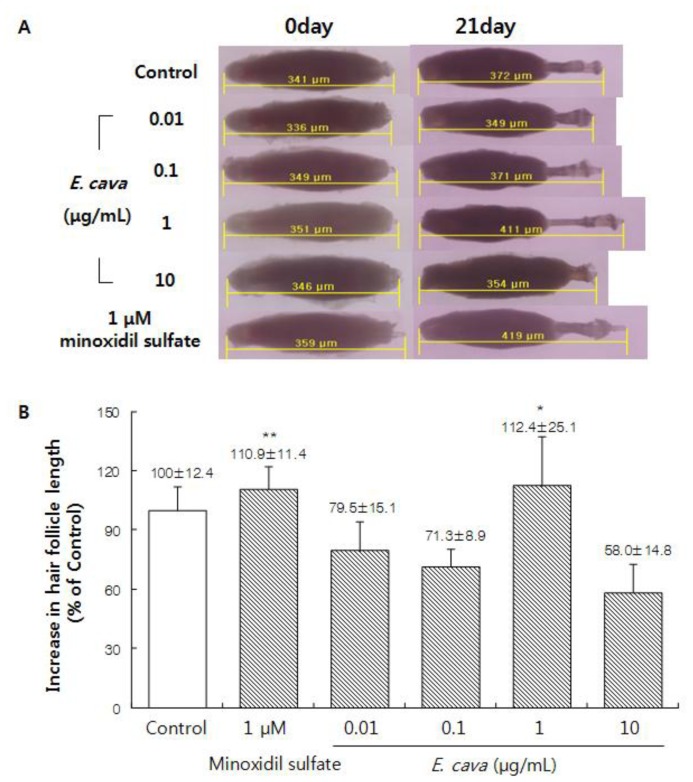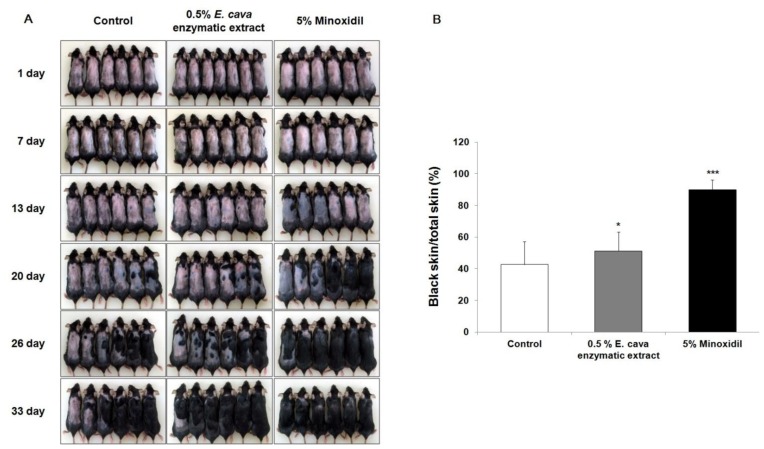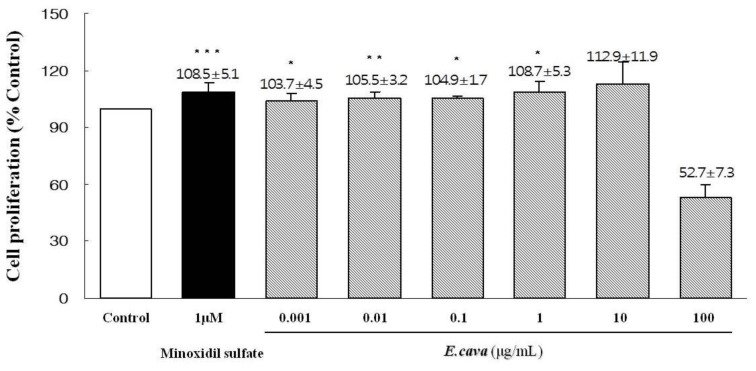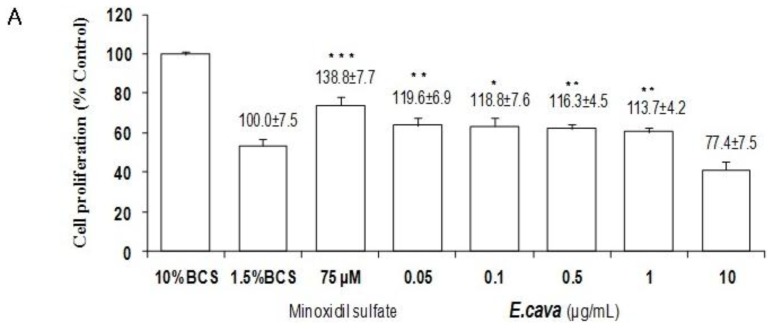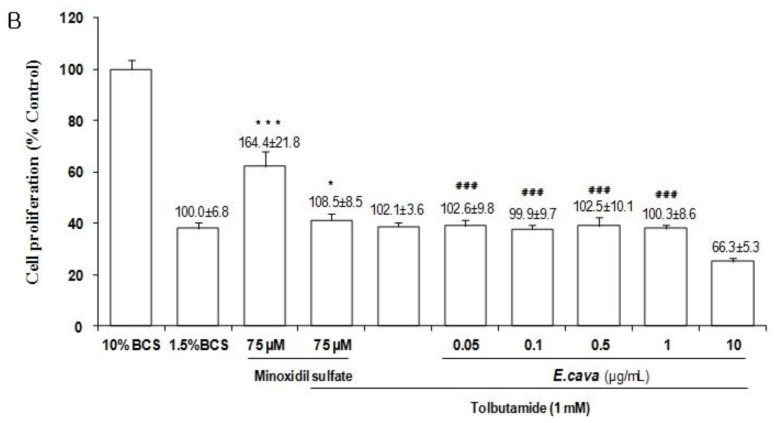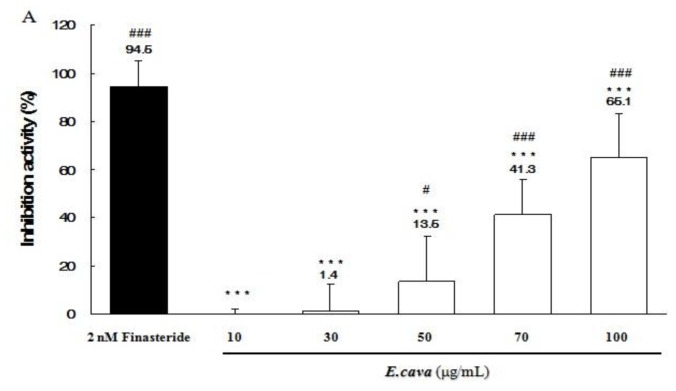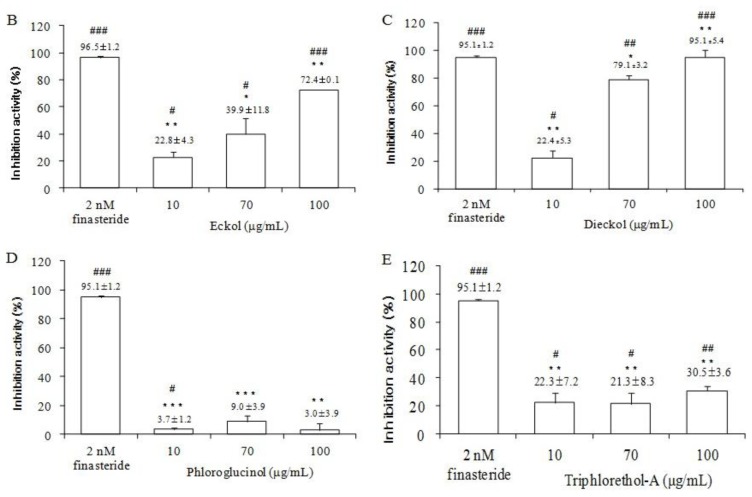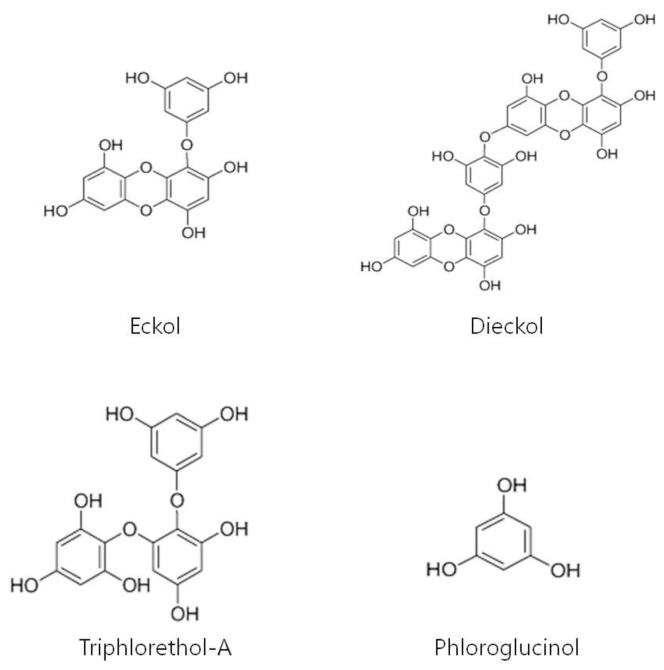Abstract
This study was conducted to evaluate the effect of Ecklonia cava, a marine alga native to Jeju Island in Korea, on the promotion of hair growth. When vibrissa follicles were cultured in the presence of E. cava enzymatic extract (which contains more than 35% of dieckol) for 21 days, E. cava enzymatic extract increased hair-fiber length. In addition, after topical application of the 0.5% E. cava enzymatic extract onto the back of C57BL/6 mice, anagen progression of the hair-shaft was induced. The treatment with E. cava enzymatic extract resulted in the proliferation of immortalized vibrissa dermal papilla cells (DPC). Especially, dieckol, among the isolated compounds from the E. cava enzymatic extract, showed activity that increased the proliferation of DPC. When NIH3T3 fibroblasts were treated with the E. cava enzymatic extract and the isolated compounds from the E. cava enzymatic extract, the E. cava enzymatic extract increased the proliferation of NIH3T3 fibroblasts, but the isolated compounds such as eckol, dieckol, phloroglucinol and triphlorethol-A did not affect the proliferation of NIH3T3 fibroblasts. On the other hand, the E. cava enzymatic extract and dieckol significantly inhibited 5α-reductase activity. These results suggest that dieckol from E. cava can stimulate hair growth by the proliferation of DPC and/or the inhibition of 5α-reductase activity.
Keywords: Ecklonia cava, dieckol, hair growth, dermal papilla cells, 5α-reductase activity, vibrissa follicle, C57BL/6 mice
1. Introduction
Androgenetic alopecia (AGA), the most common type of alopecia, is a problem in men over the age of 40. Hair loss is a growing trend in the world, however, the prevention of this condition is not simple [1]. Numerous possibilities have been discussed to treat hair loss [2]. Nevertheless, only two FDA-approved drugs have been available for AGA patients, i.e., finasteride and minoxidil [3,4]. Finasteride is a type II 5α-reductase inhibitor. It can be used in prostatic hypertrophy [5] as well as in hair loss [6]. Minoxidil was used as a drug to treat high blood pressure [7]. However, it was also found to promote hair growth [8,9], although the mechanism of minoxidil-induced hair growth is not fully understood. In a previous study, minoxidil was shown to have proliferative and anti-apoptotic effects on dermal papilla cells [10]. Moreover, it was also found to stimulate hair growth by the opening of ATP-sensitive K+-channel [11,12], the up-regulation of vascular endothelial growth factor (VEGF) [13] and the activation of the β-catenin pathway [14] in dermal papilla cells (DPC). The DPC consist of a cluster of specialized fibroblasts that play important roles in the regulation of the hair cycle through the secretion of diffusible proteins, such as insulin-like growth factor-1 (IGF-1) [15], hepatocyte growth factor (HGF) [16], VEGF [13] and transforming growth factor-β (TGF-β) [17,18].
Ecklonia cava, a brown alga, grows in the regions of Jeju Island in Korea. In previous reports, E. cava has been found to have effects such as anti-bacterial [19] and anti-inflammatory activity [20]. E. cava has been reported to contain various phlorotannins—such as eckol, 8,8′-bieckol, 8,4″-dieckol, phlorofucofuroeckol A, triphlorethol-A, phloroglucinol, dioxinodehydroeckol, fucodiphlorethol G [21–24]. Eckol was reported to have radioprotective activities [25], dieckol to have anti-inflammatory effects [26], and triphlorethol-A to have antioxidant activity [22,23]. Recently, it has been found that phloroglucinol induced apoptosis [24]. However, the effect and the underlying mechanisms of E. cava on hair growth have not been described. In this study, we examined the promotion effects and the mechanisms of E. cava extract and its components (eckol, dieckol, triphlorethol-A and phloroglucinol) on hair growth.
2. Results
2.1. The Effect of Ecklonia cava Enzymatic Extract on the Hair-Fiber Elongation of Rat Vibrissa Follicle
To determine whether E. cava enzymatic extract could induce hair growth, we examined the effect of E. cava enzymatic extract with the use of an organ culture of the rat vibrissa follicle. When the rat vibrissa follicles were treated with various concentrations of E. cava enzymatic extract for three weeks, in particular, the hair-fiber length with 1 μg/mL of E. cava enzymatic extract treatment showed a significant increase when compared to the control group (Figure 1). The result indicates that E. cava enzymatic extract contains components promoting hair growth.
Figure 1.
Hair growth effect of Ecklonia cava enzymatic extract on rat vibrissa follicles. (A,B) Individual vibrissa follicles from Wistar rats were micro dissected and then cultured in William’s E medium at 37 °C under 5% CO2. Vibrissa follicles were treated with various concentrations of E. cava enzymatic extract and minoxidil sulfate, as indicated. All experiments were performed in triplicate. The difference in the length of vibrissa follicles of the control group on day 21 was taken to be 100%. Data are presented as the percentage of the length of the treated follicles based on the mean length of the control follicles ± SE. * p < 0.05, ** p < 0.01 vs. control.
2.2. The Effect of Ecklonia cava Enzymatic Extract on the Anagen Induction in C57BL/6 Mice
To investigate whether anagen induction was promoted by E. cava enzymatic extract, we used C57BL/6 mice, since the dorsal hair is known to have a time-synchronized hair growth cycle [27]. Shaved skin of telogen C57BL/6 mice is pink, which then darkens along with anagen initiation. As shown in Figure 2, the area of black skin was significantly larger (p < 0.05) in the 0.5% E. cava enzymatic extract treated group than in the control group at 26 days after depilation. Induction of the anagen phase in the 0.5% E. cava enzymatic extract treated group was observed to be faster than in the control group. The 5% Minoxidil (MINOXYLTM) treated group, a positive control group, showed gray skin from 13 days after depilation.
Figure 2.
The effect of Ecklonia cava enzymatic extract on the anagen induction in C57BL/6 mice. After shaving, the back skins were treated with 0.5% E. cava enzymatic extract, vehicle and 5% minoxidil every day for 33 days. (A) The back skins were photographed at 1, 7, 13, 20, 26 and 33 days after depilation; (B) On day 26, the quantitative assessment of anagen induction analyzed via dotmatrix planimetry was performed. The transparency was put on a photo of a mouse to mark the areas that were in different stages (pink = telogen, anagen = black). Afterward a dotmatrix (sheet with a uniform defined dot pattern) was placed under the marked foil to calculate the percentages of the regions of interest by counting the dots. The percentage of anagen induction was calculated by the equation [(black skin/total skin) × 100]. Data are presented as the mean ± SE (n = 6). * p < 0.05, ** p < 0.01, *** p < 0.001 vs. vehicle treated control.
2.3. The Effects of Ecklonia cava Enzymatic Extract and Its Isolated Compounds on the Proliferation of Dermal Papilla Cells
We examined the effects of E. cava enzymatic extract and its isolated compounds on the proliferation of DPC. When DPC were treated with E. cava enzymatic extract in the concentrations of 0.001, 0.01, 0.1, 1, 10 and 100 μg/mL, E. cava enzymatic extract significantly promoted the proliferation of DPC compared with the vehicle-treated control at all the concentrations, except the 100 μg/mL (Figure 3). We evaluated whether the isolated compounds from E. cava enzymatic extract such as eckol, dieckol, phloroglucinol and triphlorethol-A, could promote the proliferation of DPC. DPC were treated with eckol, dieckol, phloroglucinol and triphlorethol-A, individually, at 0.005, 0.01, 0.05, 0.1, 0.5, 1 and 10 μg/mL for 4 days. The dieckol increased the proliferation of DPC by 100.5%, 103.9%, 113.5%, 106.1%, 108.1%, 98.5% and 97.3%, respectively (Table 1). The eckol also promoted the proliferation of DPC by 100.8%, 106.1%, 120.3%, 108.5%, 107.8%, 105.4% and 104.1%, respectively (Table 1). However, phloroglucinol and triphlorethol-A did not affect the proliferation of DPC (Table 1).
Figure 3.
The effect of Ecklonia cava enzymatic extract on the proliferation of dermal papilla cells. Rat vibrissa immortalized DPC (1.0 × 104 cells/mL) were plated in 96 well plates. DPC were treated with various concentrations of E. cava enzymatic extract and minoxidil sulfate, as indicated. Cell proliferation was measured using a MTT assay for 4 days. All experiments were performed in triplicate. Data are presented as the mean ± SD. * p < 0.05, ** p < 0.01, *** p < 0.001 vs. control.
Table 1.
The effects of isolated compounds from Ecklonia cava enzymatic extract on the proliferation of dermal papilla cells.
| Concentration (μg/mL) | Compounds | |||
|---|---|---|---|---|
|
| ||||
| Eckol | Dieckol | Phloroglucinol | Triphlorethol-A | |
| 0.005 | 100.8 ± 1.6 * | 100.5 ± 4.7 ** | 102.0 ± 8.5 | 101.7 ± 7.9 |
| 0.01 | 106.1 ± 4.5 * | 103.9 ± 6.5 | 100.4 ± 6.8 | 102.9 ± 3.5 |
| 0.05 | 120.3 ± 9.9 | 113.5 ± 6.2 * | 96.4 ± 5.3 | 100.4 ± 8.2 |
| 0.1 | 108.5 ± 7.7 | 106.1 ± 5.4 | 99.6 ± 4.7 | 99.3 ± 5.2 |
| 0.5 | 107.8 ± 6.7 | 108.1 ± 6.2 | 99.2 ± 4.0 | 99.4 ± 7.7 |
| 1 | 105.4 ± 6.2 | 98.5 ± 6.5 | 98.3 ± 2.3 | 103.3 ± 7.5 |
| 10 | 104.1 ± 9.7 | 97.8 ± 3.9 | 76.8 ± 5.6 | 100.6 ± 4.5 |
| 1 μM Minoxidil sulfate | 119.0 ± 8.1 *** | |||
The proliferation of the control group was regarded as 100% (not shown). All experiments were performed in triplicate. Data are presented as the mean ± SD.
p < 0.05,
p < 0.01,
p < 0.001 vs. control.
2.4. The Effects of Ecklonia cava Enzymatic Extract and Its Isolated Compounds on the Proliferation of NIH3T3 Fibroblasts
Minoxidil, a hair-growth promoting agent, has a mitotic effect on NIH3T3 fibroblasts via KATP channel opening. Whether E. cava enzymatic extract, eckol, dieckol, phloroglucinol and triphlorethol-A could act as an opener of KATP channel, proliferation of NIH3T3 fibroblasts was examined. NIH3T3 fibroblasts were treated with E. cava enzymatic extract, eckol, dieckol, phloroglucinol and triphlorethol-A at 0.05, 0.1, 0.5, 1 and 10 μg/mL. The E. cava enzymatic extract significantly increased the proliferation of NIH3T3 fibroblasts by 119.6%, 118.8%, 116.3%, 113.7% and 77.4%, respectively (Figure 4A). To evaluate whether the E. cava-induced proliferation was mediated through KATP channel opening, NIH3T3 fibroblasts were pretreated with tolbutamide, a non-selective blocker of K+ channels. Tolbutamide inhibited the E. cava-induced proliferation of NIH3T3 fibroblasts (Figure 4B). Nevertheless, it is important to note that dieckol, a major component of the E. cava enzymatic extract, did not alter the proliferation of NIH3T3 fibroblasts (data not shown). Eckol, phloroglucinol and triphlorethol-A slightly increased the proliferation of NIH3T3 fibroblasts compared with the control group (data not shown).
Figure 4.
The effect of Ecklonia cava enzymatic extract on the proliferation of NIH3T3 fibroblasts. (A,B) Mouse embryonic NIH3T3 fibroblasts (1.0 × 104 cells/mL) were plated in 96 well plates. NIH3T3 fibroblasts were treated with various concentration of E. cava enzymatic extract, as indicated. Stimulation with minoxidil served as a positive control. (B) NIH3T3 fibroblasts were pretreated with tolbutamide for 30 min prior to incubation with E. cava enzymatic extract. Cell proliferation was measured using a MTT assay for four days. All experiments were performed in triplicate. Data are presented as the mean ± SD. * p < 0.05, ** p < 0.01, *** p < 0.001 vs. control; ### p < 0.001 vs. E. cava-treated group.
2.5. The Effects of Ecklonia cava Enzymatic Extract and Its Isolated Compounds on 5α-Reductase Activities
5α-reductase activity is known to be important for preventing hair loss. We investigated the effects of E. cava enzymatic extract, eckol, dieckol, phloroglucinol and triphlorethol-A on the 5α-reductase activity using rat prostatic enzyme. As shown in Figure 5, the E. cava enzymatic extract, eckol and dieckol significantly inhibited 5α-reductase activities in a dose-dependent manner (Figure 5A–C). Especially, when the reaction mixture was incubated with 100 μg/mL of dieckol, its inhibition activity was similar to that of the finateride treated group, a positive control group (Figure 5C). However, phloroglucinol did not affect 5α-reductase activities (Figure 5D). 5α-Reductase activities in the triphlorethol-A treated group showed a slight inhibition (Figure 5E).
Figure 5.
Inhibition effects of Ecklonia cava enzymatic extract and its isolated compounds on 5α-reductase activities. (A-E) Assay of 5α-reductase inhibition was performed using a crude extract of rat prostate. The reaction mixture contained [1,2,6,7-3H] testosterone, prostatic enzyme and E. cava enzymatic extract or its isolated compounds (eckol, dieckol, phloroglucinol and triphlorethol-A). The conversion rate of testosterone (T) to dihydrotestosterone (DHT) was calculated by the equation [DHT/(T + DHT)]. Inhibition activity (%) was expressed as a percentage of reduced conversion rate compared to the control. The inhibition activity of control group was regarded as 0% (not shown). Finasteride was used as a positive control. Data are presented as the mean ± SD of three independent experiments. * p < 0.05, ** p < 0.01, *** p < 0.001 vs. finasteride; # p < 0.05, ## p < 0.01, ### p < 0.001 vs. control.
3. Discussion
In this study, the hair growth promoting effect of E. cava enzymatic extract, which contains more than 35% of dieckol, was investigated in vitro and in vivo. To the best of our knowledge, this study is the first to demonstrate that E. cava enzymatic extract and dieckol, a component of E. cava, have the potential to promote hair growth via the proliferation of dermal papilla cells and/or the inhibition of 5α-reductase activity.
The hair growth cycles, in hair follicle organ cultures of the rat vibrissa follicles, have been reported to be synchronized according to their age [28] and the isolated rat vibrissa follicles could be maintained in vitro up to 23 days [29]. Use of the organ culture methods to evaluate hair follicle growth is thought to be correlated with in vivo systems because the extent of hair growth can be observed as the sum of the function of each cell [30]. We found that the E. cava enzymatic extract increased the hair-fiber length of follicles by 12.4% at 1 μg/mL, compared with the vehicle-treated control. To evaluate the in vivo effect of E. cava enzymatic extract on the induction of the anagen phase, the hair growth promoting effect on C57BL/6 mouse was examined. The hair growth stimulating in vitro effect of E. cava enzymatic extract was also observed in vivo using C57BL/6 mice.
The hair follicle consists of several distinct epithelial cells and DPC [31,32]. Regulation of hair growth depends on the balance between proliferation and apoptosis in the DPC [10]. As shown in figure 3, E. cava enzymatic extract significantly increased the proliferation of DPC. We also examined whether the isolated compounds of E. cava extracts such as eckol, dieckol, phloroglucinol and triphlorethol-A, could increase the proliferation of DPC. We observed that eckol and dieckol increased the proliferation of DPC, whereas phloroglucinol and triphlorethol-A did not affect proliferation of DPC (Table 1).
K+ channel opening is involved in not only mitogenesis [33], but also hair growth [34]. In previous studies, minoxidil was able to potentiate the mitogenic effects on NIH3T3 fibroblasts through the KATP channel opening [35]. As shown in Figure 4, the E. cava enzymatic extract could promote the proliferation of NIH3T3 fibroblasts, which was inhibited by tobutamide, a non-selective blocker of K+ channels. The result indicates that the E. cava enzymatic extract can promote hair growth via the KATP channel opening.
Inhibition of 5α-reductase activity is important in preventing hair loss in AGA [36,37]. E. cava enzymatic extract significantly inhibited 5α-reductase activity in a dose dependent manner. Among the isolated compounds from E. cava enzymatic extract—eckol, dieckol, phloroglucinol and triphlorethol-A—dieckol was the most active. The results suggest that E. cava enzymatic extract and dieckol could have the potential for the treatment of AGA via the inhibition of 5α-reductase activities. Previous studies propose that AGA may be caused by DHT in different ways: The miniaturization of dermal papilla and hair follicles is induced by DHT, which leads to transition from anagen to catagen [38]. DHT increases the levels of transforming growth factor-β1 (TGF-β1) and TGF-β2 in dermal papilla cells, which leads to decreased proliferation of epithelial cells [39,40]. Up-regulation of dickkopf related protein-1 (DKK-1) by DHT can cause repression of the growth of epithelial cells in hair follicles [41]. In further studies, we need to examine whether that E. cava enzymatic extract and dieckol can regulate the levels of TGF-β1/β2 and DKK-1 in dermal papilla cells. The androgen action and gene expressions in dermal papilla cells (DPCs) from the human beard are known to be different from those in DPCs of the human scalp. In the future, therefore, although the structure of hair follicle in the human scalp is very similar to that of hair follicle in rat vibrissa, we need to examine whether E. cava extract and dieckol can promote hair growth of the human scalp.
4. Experimental Section
4.1. Alga Material
The brown alga, E. cava, was collected along the coasts of Jeju Island in Korea, between February and May 2010 and taxonomically identified by Professor Ki Wan Lee. The samples were washed three times in tap water to remove any attached salt, epiphytes, and sand. Then, they were rinsed carefully with fresh distilled water, and maintained in a medical refrigerator at −20 °C. The frozen samples were then lyophilized and homogenized using a grinder prior to extraction.
4.2. Preparation of E. cava Enzymatic Extract
We followed the methods reported in previous studies for the preparation of E. cava enzymatic extract [42]. To briefly state the preparation procedure, fifty grams of E. cava were homogenized with water (2 L), and mixed with 500 μL of carbohydrate enzyme (celluclast 1.5L FG, Novozyme Nordisk, Bagsvaerd, Denmark). E. cava enzymatic extract was adjusted to be within the optimum pH and temperature range of the carbohydrate enzyme and enzymatic reactions were performed for 24 h. Following extraction, the extract was boiled for 10 min at 100 °C to inactivate the enzymes. Then, E. cava enzymatic extract was clarified by centrifugation (3000 rpm, for 20 min at 4 °C) to remove the residue. E. cava enzymatic extract was adjusted to pH 7.0.
4.3. Extraction and Isolation of Phlorotannins from Ecklonia cava
Eckol, dieckol, phloroglucinol and triphlorethol-A were isolated from E. cava as previously described [43]. In short, the dried E. cava was extracted three times with 80% aqueous EtOH, and was evaporated in a vacuum. The EtOH extract was then partitioned with EtOAc. The EtOAc fraction was subjected to silica and LH-20 column chromatography. The active compounds were finally purified by reversed-phase HPLC (ThermoFisher Scientific, San Jose, CA, USA), and the purified compounds were then confirmed by comparing their LC/MS, 1H NMR data to those in the existing literature [43].
Eckol: LC/MS data (M+, m/z: 372.0 calcd for C18H12O9). 1H NMR (400 MHz, DMSO-d6) δ 9.54 (1H, s, OH-9), 9.45 (1H, s, OH-4), 9.21 (2H, s, OH-2,7) 9.16 (2H, s, OH-3′,5′), 6.14 (1H, s, H-3), 5.96 (1H, d, J = 2.8 Hz, H-8), 5.80 (1H, d, J = 1.7 Hz, H-4′), 5.78 (1H, d, J = 2.8 Hz, H-6), 5.72 (2H, J = 1.7 Hz, H-2′,6′).
Dieckol: LC/MS data (M+, m/z: 742.0 calcd for C36H22O18). 1H NMR (400 MHz, DMSO-d6) δ 9.71(1H, s, OH-9), 9.61 (1H, s, OH-9″), 9.51 (1H, s, OH-4″), 9.46 (1H, s, OH-4), 9.36 (2H, s, OH-3″,5″), 9.28 (1H, s, OH-2″), 9.23 (1H, s, OH-2), 9.22 (1H, s, OH-7″), 9.15 (2H, s, OH-3′,5′) 6.17 (1H, s, H-3″), 6.14 (1H, s, H-3), 6.02 (1H, d, J = 2.7 Hz, H-8), 5.98 (1H, d, J = 2.7 Hz, H-8″), 5.95 (1H, s, H-2′, 6″′), 5.82 (1H, d, J = 2.7 Hz, H-6), 5.81 (1H, d, J = 2.7 Hz, H-6″), 5.80 (1H, t, J = 2.0 Hz, H-4′), 5.78 (2H, d, J = 2.0 Hz, H-2′,6′).
Phloroglucinol: LC/MS data (M+, m/z: 126 calcd for C6H6O3). 1H NMR (400 MHz, DMSO-d6) δ 8.97 (3H, s, OH-1,3,5), 5.66 (3H, s, H-2,4,5).
Triphlorethol-A: LC/MS data (M+, m/z: 374.0 calcd for C18H14O9). 1H NMR (400 MHz, DMSO-d6) δ 5.7 (1H, d, J = 2.7, H-3), 6.0 (1H, d, J = 2.9, H-5), 5.8 (1H, S, H-3′), 5.8 (1H, S, H-5′), 6.0 (1H, d, J = 2.2, H-2″), 5.9 (t, J = 2.2, H-4″), 6.0 (1H, d, J = 2.2, H-6″).
The purity of eckol, dieckol, phloroglucinol and triphlorethol-A was >95%, according to the peak area of all components absorbed at each specific wavelength in HPLC analysis. Their chemical structures are shown in Figure 6, and were freshly dissolved in dimethyl sulfoxide (DMSO) (Sigma, St. Louis, MO, USA) for subsequent treatment. Further, minoxidil sulfate and minoxidil were also dissolved in DMSO for subsequent treatment. The final concentration of DMSO was adjusted to 0.2% (v/v) in the following experiment. Tolbutamide was made up as a 410 mM stock solution in ethanol and added to the culture media in a final concentration of 0.25% ethanol.
Figure 6.
Structures of eckol, dieckol, phloroglucinol and triphlorethol-A.
4.4. Animals
Male Wistar rats (3 weeks of age) were supplied from Orient Bio (Seongnam, Gyeonggi, Korea). Six-week-old female C57BL/6 mice and 8-week-old male spargue-Dawley (SD) rats were purchased from Dae-Han Biolink (Eumsung, Chungbuk, Korea) and were provided with a standard laboratory diet and water ad libitum. All animals were cared for by using protocols (20100031) approved by the Institutional Animal Care and Use Committee (IACUC) of the Jeju National University.
4.5. Isolation and Culture of Rat Vibrissa Follicles
Isolation of rat vibrissa follicles was performed as described previously [29]. Briefly, rat vibrissa follicles were harvested from male Wistar rats that were 23 days old. To accomplish this, the rats were sacrificed under carbon dioxide (CO2). Next, both the left and right mystacial pads were removed from the rats and placed in a 1:1 (v/v) solution between Earle’s balanced salts solution (EBSS, Sigma, St. Louis, MO, USA) and PBS that contained 100 unit/mL of penicillin and 100 μg/mL of streptomycin. Anagen vibrissa follicles were then carefully dissected under a stereomicroscope (Olympus, Tokyo, Japan) from posterior parts of the mystacial pads, with considerable caution to remove the surrounding connective tissue without damaging the vibrissa follicle. Using this method, we were able to routinely isolate more than 40 follicles from each animal. The isolated follicles were then placed in separate wells in 24-well plates that contained 500 μL of Williams medium E (GIBCO Inc, Grand Island, NY, USA) supplemented with 2 mM L-glutamine (Gibco Inc, Grand Island, NY, USA), 10 μg/mL insulin (Sigma, St. Louis, MO, USA), 50 nM hydrocortisone (Sigma, St. Louis, MO, USA), 100 unit/mL penicillin and 100 μg/mL streptomycin at 37 °C. They were cultivated in an atmosphere comprised of 5% CO2 and 95% air. The isolated follicles were then treated with vehicle (DMSO diluted 1:1000 in Williams medium E) as a control and E. cava enzymatic extract (0.01, 0.1, 1 and 10 μg/mL). Minoxidil sulfate (Sigma, St. Louis, MO, USA) was used as a positive control in the culture systems (Buhl et al., 1990). The culture medium was changed every 3 days and photographs of the cultured vibrissa follicles were taken using a stereomicroscope, for 3 weeks. The length of the hair follicles was measured using a DP controller (Olympus, Tokyo, Japan).
4.6. Hair Growth Activity in Vivo
Anagen was induced on the back skin of C57BL/6 mice that were in the telogen phase of the cycle by depilation, as described previously [27]. Briefly, 6-week-old female C57BL/6 mice were allowed to adapt to their new environment for one week. The anagen was then induced in the back skin of the 7-week-old female C57BL/6 mice by shaving, which led to synchronized development of anagen hair follicles. From the following day (day 1), 0.2 mL of 0.5% E. cava enzymatic extract in 50% ethanol was topically applied every day for 33 days. 5% Minoxidil (MINOXYLTM; Hyundai Pharm. Co. Ltd., Cheonan, Chungnam, Korea) was used as a positive control. The back skin of the mice was then observed and photographed at 1, 7, 13, 20, 26 and 33 days after shaving. For the quantitative assessment, dotmatrix planimetry was performed [44].
4.7. Culture and Proliferation Assay of Dermal Papilla Cells
Rat vibrissa immortalized dermal papilla cell line [45] was donated by the Skin Research Institute, Amore Pacific Corporation R & D Center, South Korea. The DPC were cultured in DMEM (Hyclone Inc., Logan, UT, USA), supplemented with 10% fetal bovine serum (Gibco BRL, Grand Island, NY, USA) and penicillin/streptomycin (100 unit/mL and 100 μg/mL, respectively), at 37 °C in a humidified atmosphere under 5% CO2.
The proliferation of DPC was evaluated by measuring the metabolic activity using a 3-[4,5-dimethylthiazol-2-yl]-2,5-diphenyltetrazolium bromide (MTT) [46]. Briefly, DPC at 1.0×104 cells/mL were seeded into 96-well plate, then cultured for 24 h in a serum-free DMEM, and then treated with vehicle (DMSO diluted 1:1000 in serum-free DMEM) as a control, E. cava extract (0.001~100 μg/mL), eckol (0.005~10 μg/mL), dieckol (0.005~10 μg/mL), phloroglucinol (0.005~10 μg/mL), triphlorethol-A (0.005~10 μg/mL) and minoxidil sulfate (1 μM), for 4 days. After incubation, 0.1 mg (50 μL of a 2 mg/mL solution) of MTT (Sigma, St. Louis, MO, USA) was added to each well, and the cells were then incubated at 37 °C for 4 h. Next, the plates were centrifuged at 1000 rpm for 5 min at room temperature and the media was then carefully aspirated. 200 μL of DMSO was then added to each well to dissolve the formazan crystals and the absorbance of the plates, at 540 nm, was then read immediately on a microplate reader (BioTek Instrument, Inc., Winooski, VT, USA). All experiments were performed three times and the mean absorbance values were calculated. The results are expressed as a percentage of absorbance caused by treatment with the extract or the active component compared to those of the vehicle treated controls.
4.8. Culture and Proliferation Assay of NIH3T3 Fibroblasts
The mouse embryonic NIH3T3 fibroblasts were purchased from ATCC (Rockville, MD, USA) and cultured in ATCC-formulated Dulbecco’s Modified Eagle’s Medium (DMEM), supplemented with 10% (v/v) heat-activated bovine calf serum (BCS), 100 unit/mL penicillin and 100 μg/mL streptomycin at 37 °C atmosphere and 5% CO2.
The proliferation of NIH3T3 fibroblasts was also evaluated by measuring the metabolic activity using MTT assay [46]. NIH3T3 fibroblasts, at 1.0 × 104 cells/mL, were seeded into a 96-well plate. Cells were incubated for 24 h with DMEM supplemented with 10% BCS, then washed with phosphate buffered saline (PBS, Sigma, St. Louis, MO, USA). The cells were maintained with DMEM supplemented with 10% BCS or 1.5% BCS and treated with vehicle (DMSO) as a control, E. cava extract (0.05~10 μg/mL), eckol (0.05~10 μg/mL), dieckol (0.05~10 μg/mL), phloroglucinol (0.05~10 μg/mL), triphlorethol-A (0.05~10 μg/mL) and minoxidil (75 μM), for 4 days. To clarify whether proliferation of NIH3T3 fibroblasts is regulated by KATP channel opening, NIH3T3 fibroblasts were pretreated with tolbutamide (2 mM), a non-selective blocker of K+ channel, for 30 min prior to incubation with E. cava enzymatic extract for 4 days. All experiments were performed three times and the mean absorbance values were calculated. The results are expressed as the percentage in the absorbance caused by treatment with the extract or the active component compared to those of the vehicle untreated controls.
4.9. Assay of Rat Prostatic 5α-Reductase
Male SD rats (8 weeks) were sacrificed with carbon dioxide (CO2). The prostates of rats were dissected, freed of their capsules, then washed with saline, and stored at −80 °C. Frozen tissues were thawed on ice and procedures were carried out at 4 °C. The tissues were homogenized with Polytron homogenizer (Brinkman Instruments, Wesrbury, NY, USA) in 5–6 tissue volumes of medium A (0.32 M sucrose, 1 mM dithiothreitol (DTT), 0.2 mM phenylmethylsulfonylfluoride (PMSF), and 20 mM potassium phosphate buffer pH 6.6). The homogenates were centrifuged at 100,000 g for 60 min. The pellets were recovered, washed with three tissue volumes of medium A and centrifuged two additional times at 400 g at 0 °C for 10 min. The washed pellets were suspended in medium A and stored at −80 °C until use. The suspension (2.5 mg protein/mL for Rat prostates, determined by the Bradford method) was used as source of 5α-reductase.
5α-reductase activities were assayed as previously described [47]. The reaction mixture contained a final volume of 500 μL: one millimole DTT, 40 mM potassium phosphate buffers, 2 mM NADPH, Testosterone including 120 n Ci [1,2,6,7-3H]. The reaction in triplicate was started when it was added to the rat prostatic enzyme fraction (250 μg protein), 0.2% DMSO as a control, E. cava extract (10, 30, 50, 70 and 100 μg/mL), eckol (10, 70 and 100 μg/mL), dieckol (10, 70 and 100 μg/mL), phloroglucinol (10, 70 and 100 μg/mL) and triphlorethol-A (10, 70 and 100 μg/mL). Finasteride 2 nM (MERCK SHARP & DOHME, South Granville, Australia) was used as a positive control. The mixture was incubated at 37 °C for 60 min, and then stopped by adding 1 mL of ethyl acetate and mixing for 1 min. After centrifugation at 1000 g for 5 min, the organic phase was removed which then was dried under a heating plate, dissolved in 50 μL of ethyl acetate containing 500 μg/mL testosterone and 500 μg/mL dihydrotestosterone (DHT) and applied to a silica gel 60 F254 TLC plate (Merck, Darmstadt, Germany). The plate was developed in a solvent system consisting of an ethyl acetate:cyclohexane (1:1) solution, the plate then was air dried. Testosterone was visibly seen under the UV light (254 nm) and DHT was detected using 10% H2SO4 solution via posteriorly heating the plate. Under these conditions, DHT will be shown as a dark yellow color. Areas containing androgen were removed and the strips were soaked in the 5 mL of ULTIMA GOLDTM Cocktails (PerkinElmer, Inc., Waltham, MA, USA) and the radioactivity level was then measured via a liquid scintillation counter (Packard Bioscience, Meriden, CT, USA). The activity of 5α-reductase was expressed as the ratio [DHT/(T + DHT)] × 100.
4.10. Statistical Analyses
Each experiment was performed at least in triplicate. Results are expressed as mean ± SD or mean ± SE from three separate experiments. The Student’s t test and one-way ANOVA test were used to determine the statistical significance.
5. Conclusions
In conclusion, this study demonstrated that dieckol, a principal component of E. cava, could stimulate hair growth through the proliferation of dermal papilla cells and the inhibition of 5α-reductase activity. These finding indicate that dieckol from E. cava enzymatic extract is a possible therapeutic compound for treatment of hair loss.
Acknowledgments
This research was a part of the project titled “Development of product and material promoting hair-growth from Jeju marine algae” funded by the Ministry of Land, Transport and Maritime Affairs, Korea.
References
- 1.Cotsarelis G., Millar S.E. Towards a molecular understanding of hair loss and its treatment. Trends Mol. Med. 2001;7:293–301. doi: 10.1016/s1471-4914(01)02027-5. [DOI] [PubMed] [Google Scholar]
- 2.Price V.H. Treatment of hair loss. N. Engl. J. Med. 1999;341:964–973. doi: 10.1056/NEJM199909233411307. [DOI] [PubMed] [Google Scholar]
- 3.Kaufman K.D., Olsen E.A., Whiting D., Savin R., DeVillez R., Bergfeld W., Price V.H., van Neste D., Roberts J.L., Hordinsky M., et al. Finasteride in the treatment of men with androgenetic alopecia. Finasteride Male Pattern Hair Loss Study Group. J. Am. Acad. Dermatol. 1998;39:578–589. doi: 10.1016/s0190-9622(98)70007-6. [DOI] [PubMed] [Google Scholar]
- 4.Burton J.L., Marshall A. Hypertrichosis due to minoxidil. Br. J. Dermatol. 1979;101:593–595. [PubMed] [Google Scholar]
- 5.Gromley G.J. Finasteride: A clinical review. Biomed. Pharmacother. 1995;49:319–324. doi: 10.1016/0753-3322(96)82658-8. [DOI] [PubMed] [Google Scholar]
- 6.McClellan K.J., Markham A. Finasteride: A review of its use male pattern hair loss. Drugs. 1999;57:111–126. doi: 10.2165/00003495-199957010-00014. [DOI] [PubMed] [Google Scholar]
- 7.Mehta P.K., Mamdani B., Shansky R.M., Mahurkar S.D., Dunea G. Severe hypertension. Treatment with minoxidil. J. Am. Med. Assoc. 1975;233:249–252. [PubMed] [Google Scholar]
- 8.Tanigaki-Obana N., Ito M. Effects of cepharanthine and minoxodil on proliferation, differentiation and keratinozation of cultured cells from the murine hair apparatus. Arch. Dermatol. Res. 1992;284:290–296. doi: 10.1007/BF00372583. [DOI] [PubMed] [Google Scholar]
- 9.Uno H., Cappas A., Schlagel C. Cyclic dynamics of hair follicles and the effect of minoxidil on the bald scalps of stumptailed macaques. Am. J. Dermatopathol. 1985;7:283–297. doi: 10.1097/00000372-198506000-00012. [DOI] [PubMed] [Google Scholar]
- 10.Han J.H., Kwon O.S., Chung J.H., Cho K.H., Eun H.C., Kim K.H. Effect of minoxodil on proliferation and apoptosis in dermal papilla cells of human hair follicle. J. Dermatol. Sci. 2004;34:91–98. doi: 10.1016/j.jdermsci.2004.01.002. [DOI] [PubMed] [Google Scholar]
- 11.Hamaoka H., Minakuchi K., Miyoshi H., Arase S., Chen C.H., Nakaya Y. Effect of K+ channel openers on K+ channel in cultured human dermal papilla cells. J. Med. Invest. 1997;44:73–77. [PubMed] [Google Scholar]
- 12.Shorter K., Farjo N.P., Picksley S.M., Randall V.A. Human hair follicles contain two forms of ATP-sensitive potassium channels, only one of which is sensitive to minoxidil. FASEB J. 2008;22:1725–1736. doi: 10.1096/fj.07-099424. [DOI] [PubMed] [Google Scholar]
- 13.Lachgar S., Moukadiri H., Jonca F., Charveron M., Bouhaddioui N., Gall Y., Bonafe J.L., Plouet J. Vascular endothelial growth factor is an autocrine growth factor for hair dermal papilla cells. J. Invest. Dermatol. 1996;106:17–23. doi: 10.1111/1523-1747.ep12326964. [DOI] [PubMed] [Google Scholar]
- 14.Kwack M.H., Kang B.M., Kim M.K., Kim J.C., Sung Y.K. Minoxidil activates beta-catenin pathway in human dermal papilla cells: A possible explanation for its anagen prolongation effect. J. Dermatol. Sci. 2011;62:154–159. doi: 10.1016/j.jdermsci.2011.01.013. [DOI] [PubMed] [Google Scholar]
- 15.Itami S., Kurata S., Takayasu S. Androgen induction of follicular epithelial cell growth is mediated via insulin-like growth factor-I from dermal papilla cells. Biochem. Biophys. Res. Commun. 1995;212:988–994. doi: 10.1006/bbrc.1995.2067. [DOI] [PubMed] [Google Scholar]
- 16.Shimaoka S., Imai R., Ogawa H. Dermal papilla cells express hepatocyte growth factor. J. Dermatol. Sci. 1994;7:S79–S83. doi: 10.1016/0923-1811(94)90038-8. [DOI] [PubMed] [Google Scholar]
- 17.Soma T., Dohrmann C.E., Hibino T., Raftery L.A. Profile of transforming growth factor-beta responses during the murine hair cycle. J. Invest. Dermatol. 2003;121:65–68. doi: 10.1046/j.1523-1747.2003.12516.x. [DOI] [PubMed] [Google Scholar]
- 18.Soma T., Tsuji Y., Hibino T. Involvement of transforming growth factor-beta2 in catagen induction during the human hair cycle. J. Invest. Dermatol. 2002;118:993–997. doi: 10.1046/j.1523-1747.2002.01746.x. [DOI] [PubMed] [Google Scholar]
- 19.Choi J.G., Kang O.H., Brice O.O., Lee Y.S., Chae H.S., Oh Y.C., Sohn D.H., Park H., Choi H.G., Kim S.G., et al. Antibacterial activity of Ecklonia cava against methicillin-resistant Staphylococcus aureus and Salmonella spp. Foodborne. Pathog. Dis. 2010;7:435–441. doi: 10.1089/fpd.2009.0434. [DOI] [PubMed] [Google Scholar]
- 20.Kim T.H., Bae J.S. Ecklonia cava extracts inhibit lipopolysaccharide induced inflammatory responses in human endothelial cell. Food Chem. Toxicol. 2010;48:1682–1687. doi: 10.1016/j.fct.2010.03.045. [DOI] [PubMed] [Google Scholar]
- 21.Ahn M.J., Yoon K.D., Min S.Y., Lee J.S., Kim J.H., Kim T.G., Kim S.H., Kim N.G., Huh H., Kim J. Inhibition of HIV-1 reverse transcriptase and protease by phlorotannins from the brown alga Ecklonia cava. Biol. Pharm. Bull. 2004;27:544–547. doi: 10.1248/bpb.27.544. [DOI] [PubMed] [Google Scholar]
- 22.Kang K.A., Lee K.H., Chae S., Koh Y.S., Yoo B.S., Kim J.H., Ham Y.M., Baik J.S., Lee N.H., Hyun J.W. Triphlorethol-A from Ecklonia cava protects V79-4 lung fibroblast against hydrogen peroxide induced cell damage. Free Radic. Res. 2005;39:883–892. doi: 10.1080/10715760500161165. [DOI] [PubMed] [Google Scholar]
- 23.Kang K.A., Lee K.H., Park J.W., Lee N.H., Na H.K., Surh Y.J., You H.J., Chung M.H., Hyun J.W. Triphlorethol-A induces heme oxygenase-1 via activation of ERK and NF-E2 related factor 2 transcription factor. FEBS Lett. 2007;581:2000–2008. doi: 10.1016/j.febslet.2007.04.022. [DOI] [PubMed] [Google Scholar]
- 24.Kong C.S., Kim J.A., Yoon N.Y., Kim S.K. Induction of apoptosis by phloroglucinol derivative from Ecklonia cava in MCF-7 human breast cancer cells. Food Chem. Toxicol. 2009;47:1653–1658. doi: 10.1016/j.fct.2009.04.013. [DOI] [PubMed] [Google Scholar]
- 25.Park E., Ahn G.N., Lee N.H., Kim J.M., Yun J.S., Hyun J.W., Jeon Y.J., Wie M.B., Lee Y.J., Park J.W., Jee Y. Radioprotective properties of eckol against ionizing radiation in mice. FEBS Lett. 2008;582:925–930. doi: 10.1016/j.febslet.2008.02.031. [DOI] [PubMed] [Google Scholar]
- 26.Jung W.K., Heo S.J., Jeon Y.J., Lee C.M., Park Y.M., Byun H.G., Choi Y.H., Park S.G., Choi I.W. Inhibitory effects and molecular mechanism of dieckol isolated from marine brown alga on COX-2 and iNOS in microglial cells. Agric. Food Chem. 2009;57:4439–4446. doi: 10.1021/jf9003913. [DOI] [PubMed] [Google Scholar]
- 27.Müller-Röver S., Handjiski B., van der Veen C., Maurer M., Eichmüller S., Ling G., Hofmann U., Foitzik K., Mecklenburg L., Handjiski B. A comprehensive guide for the accurate classification of murine hair follicles in distinct hair cycle stages. J. Invest. Dermatol. 2001;117:3–15. doi: 10.1046/j.0022-202x.2001.01377.x. [DOI] [PubMed] [Google Scholar]
- 28.Ibrahim L., Wright E.A. The growth of rats and mice vibrissae under normal and some abnormal conditions. J. Embryol. Exp. Morphol. 1975;33:831–844. [PubMed] [Google Scholar]
- 29.Philpott M.P., Kealey T. Cyclical changes in rat vibrissa follicles maintained in vitro. J. Invest. Dermatol. 2000;115:1152–1155. doi: 10.1046/j.1523-1747.2000.00183.x. [DOI] [PubMed] [Google Scholar]
- 30.Philpott M.P., Green M.R., Kealey T. Human hair growth in vitro. J. Cell Sci. 1990;97:463–471. doi: 10.1242/jcs.97.3.463. [DOI] [PubMed] [Google Scholar]
- 31.Botchkarev V.A., Kishimoto J. Molecular control of epithelial-mesenchymal interactions during hair follicle cycling. J. Investig. Dermatol. Symp. Proc. 2003;8:46–55. doi: 10.1046/j.1523-1747.2003.12171.x. [DOI] [PubMed] [Google Scholar]
- 32.Paus R., Cotsarelis G. The biology of hair follicles. N. Engl. J. Med. 1999;341:491–497. doi: 10.1056/NEJM199908123410706. [DOI] [PubMed] [Google Scholar]
- 33.Dubois J.M., Rouzaire-Dubois B. Role of potassium channels in mitogenesis. Prog. Biophys. Mol. Biol. 1993;59:1–21. doi: 10.1016/0079-6107(93)90005-5. [DOI] [PubMed] [Google Scholar]
- 34.Harmon C.S., Lutz D., Ducote J. Potassium channel openers stimulate DNA synthesis in mouse epidermal keratinocyte and whole hair follicle cultures. Skin Pharmacol. 1993;6:170–178. doi: 10.1159/000211131. [DOI] [PubMed] [Google Scholar]
- 35.Sanders D.A., Fiddes I., Thompson D.M., Philpott M.P., Westgate G.E., Kealey T. In the absence of streptomycin, minoxidil potentiates the mitogenic effects of fetal calf serum, insulin-like growth factor 1, and platelet-derived growth factor on NIH 3T3 fibroblasts in a K+ channel-dependent fashion. J. Invest. Dermatol. 1996;107:229–234. doi: 10.1111/1523-1747.ep12329697. [DOI] [PubMed] [Google Scholar]
- 36.Whiting D.A. Male pattern hair loss: Current understanding. Int. J. Dermatol. 1998;37:561–566. doi: 10.1046/j.1365-4362.1998.00542.x. [DOI] [PubMed] [Google Scholar]
- 37.Trüeb R.M. Molecular mechanisms of androgenetic alopecia. Exp. Gerontol. 2002;37:981–990. doi: 10.1016/s0531-5565(02)00093-1. [DOI] [PubMed] [Google Scholar]
- 38.Sinclair R. Male pattern androgenetic alopecia. BMJ. 1998;317:865–869. doi: 10.1136/bmj.317.7162.865. [DOI] [PMC free article] [PubMed] [Google Scholar]
- 39.Hibino T., Nishiyama T. Role of TGF-beta2 in the human hair cycle. J. Dermatol. Sci. 2004;35:9–18. doi: 10.1016/j.jdermsci.2003.12.003. [DOI] [PubMed] [Google Scholar]
- 40.Inui S., Fukuzato Y., Nakajima T., Yoshikawa K., Itami S. Androgen-inducible TGF-beta1 from balding dermal papilla cells inhibits epithelial cell growth: A clue to understand paradoxical effects of androgen on human hair growth. FASEB J. 2002;16:1967–1969. doi: 10.1096/fj.02-0043fje. [DOI] [PubMed] [Google Scholar]
- 41.Kwack M.H., Sung Y.K., Chung E.J., Im S.U., Ahn J.S., Kim M.K., Kim J.C. Dihydrotestosterone-inducible dickkopf 1 from balding dermal papilla cells causes apoptosis in follicular keratinocytes. J. Invest. Dermatol. 2008;128:262–269. doi: 10.1038/sj.jid.5700999. [DOI] [PubMed] [Google Scholar]
- 42.Heo S.J., Jeon Y.J., Lee J., Kim H.T., Lee K.W. Antioxidant effect of enzymatic hydrolyzates from a Kelp, Ecklonia cava. Algae. 2003;18:341–347. [Google Scholar]
- 43.Li Y., Qian Z.J., Ryu B.M., Lee S.H., Kim M.N., Kim S.K. Chemical components and its antioxidant properties in vitro: An edible marine brown alga, Ecklonia cava. Bioorg. Med. Chem. 2009;17:1963–1973. doi: 10.1016/j.bmc.2009.01.031. [DOI] [PubMed] [Google Scholar]
- 44.Ohnemus U., Uenalan M., Conrad F., Handjiski B., Mecklenburg L., Nakamura M., Inzunza J., Gustafsson J.A., Paus R. Hair cycle control by estrogens: Catagen induction via estrogen receptor (ER)-alpha is checked by ER beta signaling. Endocrinology. 2005;146:1214–1225. doi: 10.1210/en.2004-1219. [DOI] [PubMed] [Google Scholar]
- 45.Filsell W., Little J.C., Stones A.J., Granger S.P., Bayley S.A. Transfection of rat dermal papilla cells with a gene encoding a temperature-sensitive polyomavirus large T antigen generates cell lines a differentiated phenotype. J. Cell Sci. 1994;107:1761–1772. doi: 10.1242/jcs.107.7.1761. [DOI] [PubMed] [Google Scholar]
- 46.Carmichael J., DeGraff W.G., Gazdar A.F., Minna J.D., Mitchell J.B. Evaluation of a tetrazolium-based semiautomated colorimetric assay: Assessment of chemosensitivity testing. Cancer Res. 1987;47:936–942. [PubMed] [Google Scholar]
- 47.Hirosumi J., Nakayama O., Fagan T., Sawada K., Chida N., Inami M., Takahashi S., Notsu Y., Okuhara M.J. FK143, a novel nonsteroidal inhibitor of steroid 5-reductase: (1) In vitro effects on human and animal prostatic enzymes. Steroid. Biochem. Mol. Biol. 1995;52:357–363. doi: 10.1016/0960-0760(94)00187-q. [DOI] [PubMed] [Google Scholar]



